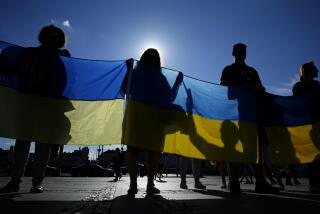Ike-Like Diplomacy Instead of War
- Share via
WASHINGTON -- A hostile government with evil designs and the means to attack America with weapons of mass destruction. Could a preventive war waged by the United States free the world of this danger?
The Eisenhower administration, faced with this imminent threat, considered the idea of a preventive war, then dismissed it. That history has clear lessons for the Bush administration as it prepares to wage war against Iraq to prevent Saddam Hussein from developing nuclear bombs.
When the Soviet Union, already armed with nuclear weapons, acquired a long-range ballistic missile capability in 1957, Dwight Eisenhower became the first president to face a new reality. The United States was vulnerable to a nuclear attack that could kill millions of Americans. It was a watershed in the history of a people who believed that two oceans guaranteed their security.
That sense of vulnerability could have devastated public morale and led to cataclysmic war. It did not, and Eisenhower’s handling of that turning point in U.S. history testifies to his great leadership. Unfortunately, he has not received the credit he deserves for this achievement. Eisenhower kept the lid on a volatile situation as only a president of his stature could, refusing to let America be turned into what he called a “garrison state.” It is certain that he would have pressed for an allied response to today’s military challenges.
Hawks in his administration urged Eisenhower to adopt an aggressive “rollback” or “line in the sand” policy toward the Soviet Union. In the early 1950s, the Joint Chiefs of Staff had expected a showdown with Moscow in 1959 or 1960, when the growing Soviet stockpile of nuclear weapons would neutralize the U.S. advantage. They pressed Eisenhower to go on the geopolitical offensive against the threat. Adm. Arthur W. Radford, chairman of the Joint Chiefs, told Eisenhower that forestalling Soviet action was far preferable to reacting later.
It is not surprising that, at such an unpredictable time, a preventive war seemed a reasonable option. But, pragmatic realist that he was, Eisenhower chose containment, a policy that required patience and did not promise immediate results. He opposed unilateral U.S. action, believing that allies were essential to achieving U.S. interests in the international arena. His administration created the military structure that undergirds nuclear deterrence. But to Eisenhower, war was the last resort.
Eisenhower instead wanted to open direct communications with Moscow. In 1958, he proposed an international conference of experts to discuss measures that might prevent a surprise attack. I represented the U.S. Atomic Energy Commission in that short-lived conference in Geneva. The Soviet delegation, led by a senior member of the Soviet government, pushed for comprehensive disarmament as the best solution. The U.S. delegation tried to keep the focus on technical issues.
George B. Kistiakowsky, a top member of the U.S. delegation and also of the team that developed the U.S. atomic bomb, spoke passionately about the crossroads of technology and a ruthless enemy: “The first act of a future war can be in itself a staggering human catastrophe.... [It] may blow whole cities sky-high and annihilate modern human society.... [An enemy would] try to choose as instruments of [its] surprise attack those weapons systems and aggressive forces [that would give no warning to] the prospective victim and whose capabilities for quick devastation are greatest.”
These are conditions that cry out for preventive war. Eisenhower faced a dictator with more blood on his hands than today’s batch of despots. Josef Stalin had killed not just thousands but millions of his own people. His successor, Nikita S. Khrushchev, was more moderate at home, but he recklessly sought to use growing Soviet nuclear and missile capabilities to extract concessions from the West.
Eisenhower stood firm against both the advocates of preventive war and the Soviets. He favored a strong defense, but he also believed in the power of negotiations to solve international problems. The 1958 conference on preventing surprise nuclear attacks did not produce direct results, but it encouraged high-level dialogue between the U.S. and the USSR. Another Eisenhower-launched negotiation that year did lead to a concrete outcome that helped turn the U.S.-Soviet rivalry away from war: the Limited Nuclear Test Ban Treaty, which was signed in 1963 during the Kennedy administration. The struggle between the two powers lasted decades longer, but the likelihood of nuclear war receded.
The lesson? An assumption of inevitability, as Eisenhower might say, is an abstraction that can get one down -- and lead to a catastrophe.
Worry that nuclear arms or other weapons of mass destruction could be acquired by rogue states also is not unprecedented in U.S. experience. In the years after the communist revolution of 1949, China was regarded by many as a rogue state. In the 1960s, when it was on the brink of acquiring nuclear weapons, there was some talk at high levels in both the U.S. and Soviet governments of a “surgical strike,” a form of preventive war. Again, the hand of war was stayed, and China today is an ally in the global war against terrorism.
The lesson? History seems to have a way of refuting those who say time is not on our side.
Eisenhower’s emphasis on the long haul, his distaste for borrowing trouble from an uncertain future, his vision of what a democratic society should be, and his willingness to try diplomacy served us well when we faced the threat of imminent destruction in the 1950s. His style of statecraft could serve us well today.
More to Read
Sign up for Essential California
The most important California stories and recommendations in your inbox every morning.
You may occasionally receive promotional content from the Los Angeles Times.













